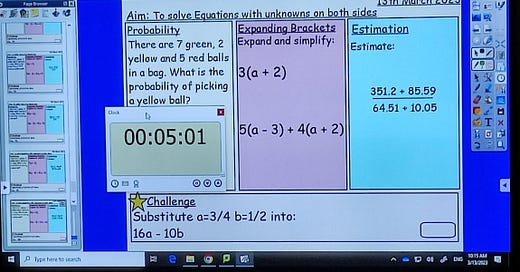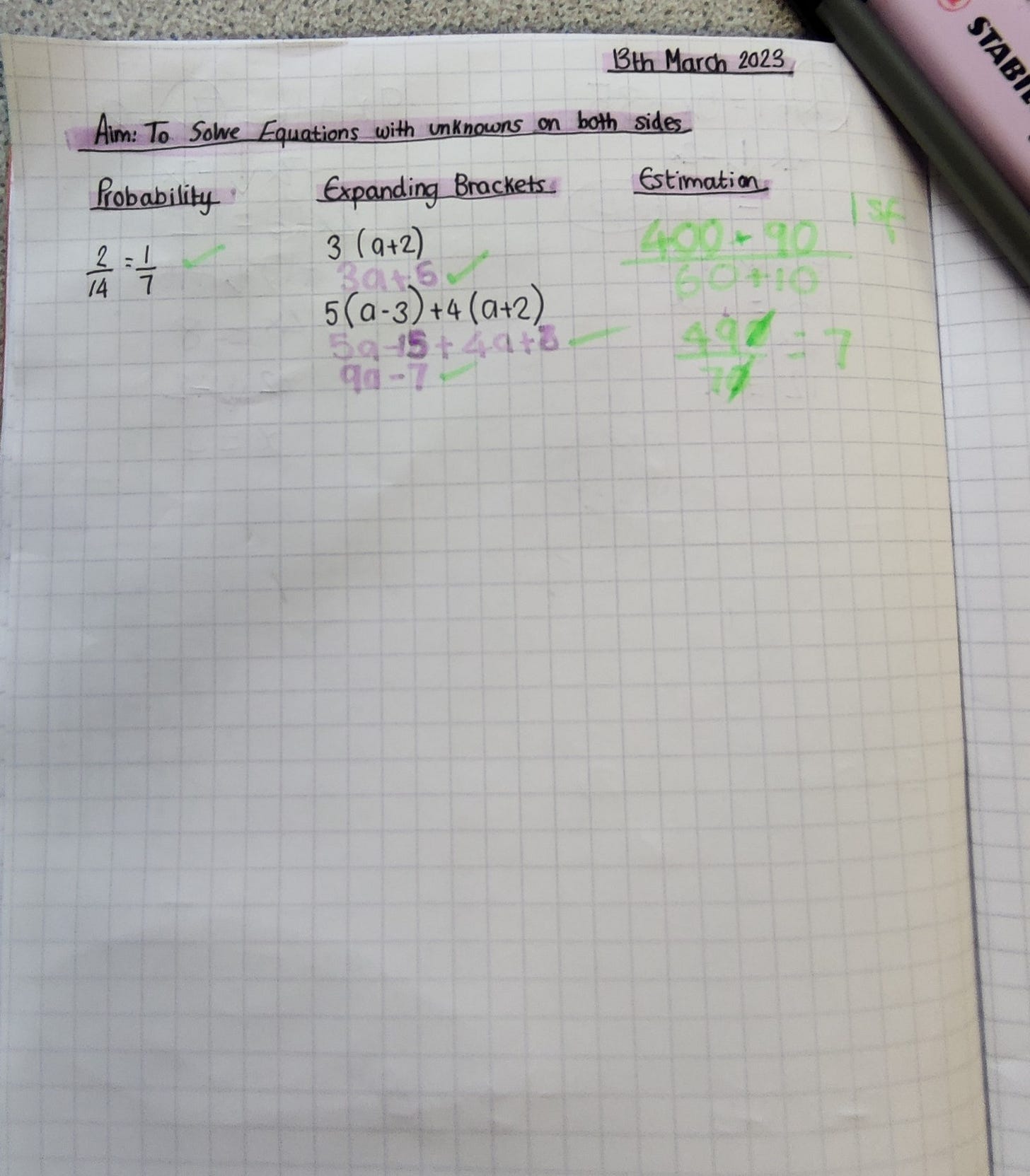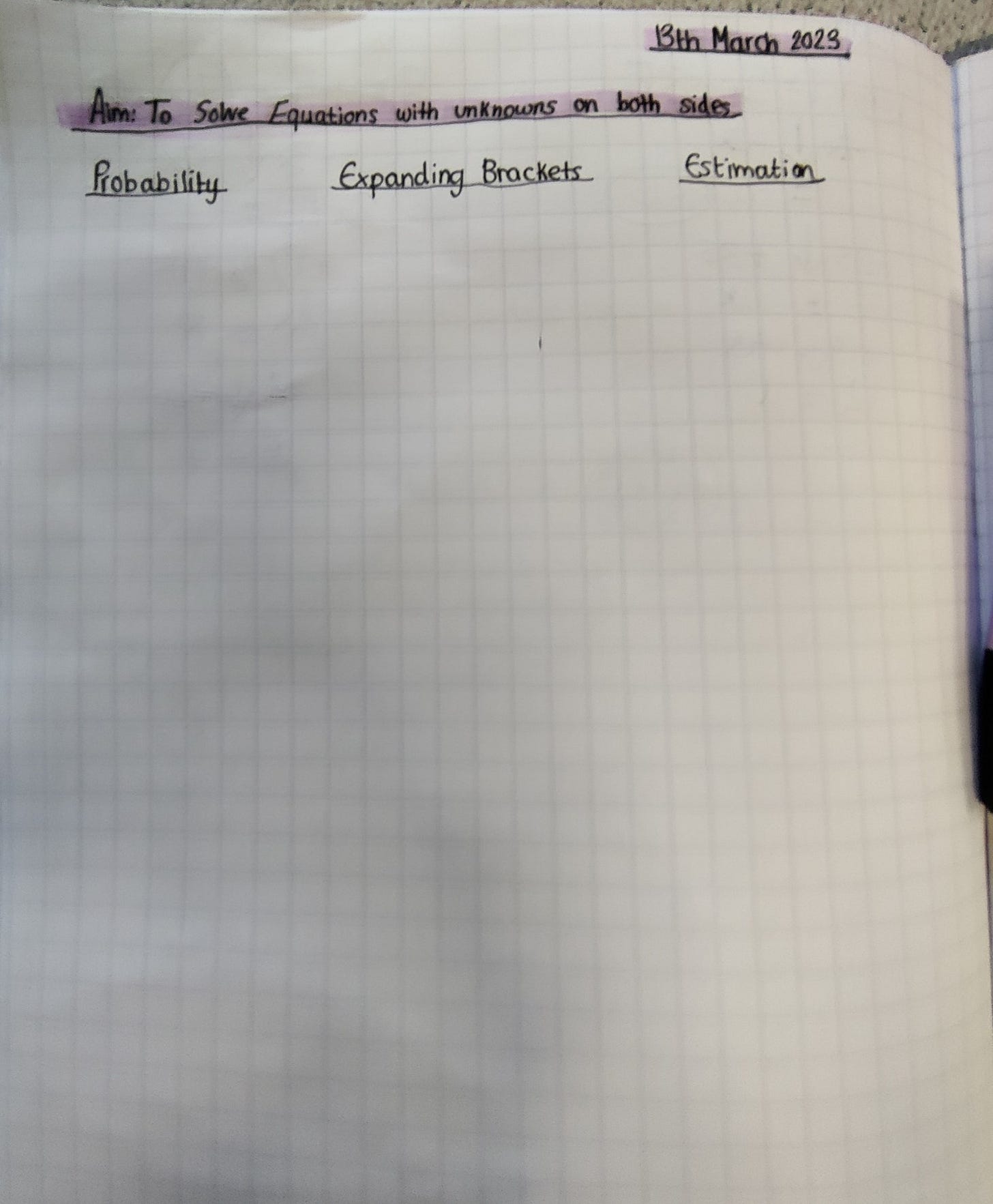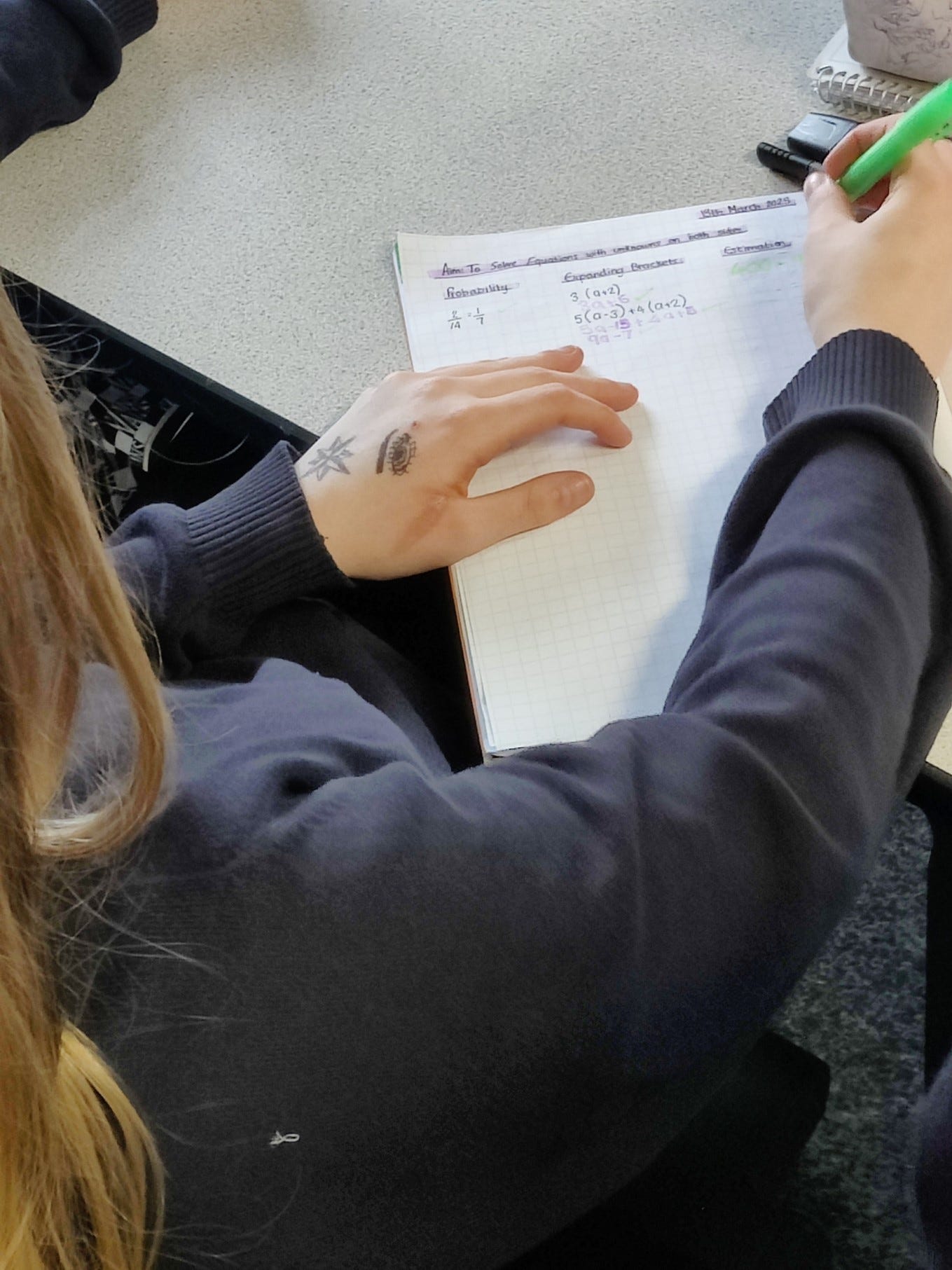Hello!
I hope you are all well.
Thank you for such a great response to last week’s newsletter on The Myth of Copying Things Down. Since the post went live there have been some fantastic discussions in the comments and on Twitter. I have added my favourite reflections towards the bottom of the post, so please do check them out to see other teachers’ perspectives and experiences with copying.
Finally, if you are not already, please consider subscribing to this newsletter by putting your email in the box below, so you never miss a new edition.
Part 1: What is busy tricking?
Science teacher and author, Adam Boxer, has a knack for spotting something, describing it with clarity, and then giving it a catchy name so we can all discuss it with a shared vocabulary. When Adam came on my Tips for Teachers podcast, he described a behaviour students often engage in that he calls busy tricking.
Busy tricking is when students give the outward impression that they are engaging with work, but in reality, they are taking actions to avoid thinking. Slowly copying down the date, title and lesson objectives are classic busy tricking behaviours at the start of a lesson when the Do Now is also on the board. Another is copying out the questions of an exercise to avoid having to think about the answers.
The obvious issue with busy tricking compared to more obvious forms of off-task behaviour - such as chatting to their partner, staring out of the window, or point-blank refusing to pick up a pen - is that it can be difficult for the teacher to pick up on, especially when they have a class of 30+ students.
Part 2: Busy tricking in action
I saw a classic example of busy tricking in action when I visited a school to support their maths department. I joined a lesson right at the start with the Do Now on the board:
As you can see, the students were given five minutes to complete the task in their exercise books.
Here is a photo of what one of the student’s books looked like at the end of the five minutes after the teacher had gone through the answers to the Do Now on the board:
Looks pretty good, right? The department has a policy that corrections are to be done in green pen. The student appears to have successfully answered questions 1 and 2, struggled on question 3, but then copied the correct solution down from the board as instructed. Anyone flicking through this student’s book would be very happy with how they have engaged with the Do Now.
But there is a twist. Because, at the end of the allocated 5 minutes, right before the teacher began going through the answers, this is what the student’s book actually looked like:
The student has spent all of the Do Now busy tricking. She had slowly copied down the date and title. She had slowly copied down the topics of the Do Now questions. Notice she had also added the flourish of a lovely purple highlighter. From the front of the room (she was sitting at the back), she gave the impression of a student diligently getting on with her work - far more so than some of her peers who were chatting to their partners and drawing the attention of the teacher.
And then when the teacher started going through the answer, the student picked up her pen and began to copy what was written on the board into her book:
Part 3: What is the problem?
Quite simply, the student learned very little, if anything, during the Do Now. How could she have, when she hadn’t needed to engage in any thought? But because the teacher was unable to pick up on that during those 5 minutes, the student was able to produce something in her book that looked like learning, and so that lack of learning went unnoticed. This has all the hallmarks of The Myth of Copying Things Down that we discussed last week.
And this is by no means an isolated case. I am in the privileged position these days that I get to see lots of lessons in lots of different schools every week. Unlike the teacher, who has lots of other things to think about, I am able to choose to focus my attention on specific things at any given time. And believe me, busy tricking is rife.
Part 4: What is the solution?
Busy tricking can occur at any stage of a lesson, but is particularly prevalent during the Do Now as students are slow to settle and the teacher is often preoccupied. I think there are four ways we can combat it.
First, we need to ensure students know the purpose of the activity we are asking them to do. The Do Now is particularly important here. If I ask a teacher why they do a Do Now like the one above, they will tell me it is to provide retrieval practice on topics students have encountered in the past to give students the best chance of remembering them. If I ask a student - as I regularly do - why they are doing the Do Now, they often reply along the line of: “to keep us busy while Sir does the register”, or “dunno”. If students understand the purpose of what they are doing, they are more likely to buy into it.
Second, we need to circulate. It is very tempting to use the time students are working on the Do Now to get a bit of admin done: do the register, hand back homework, give out pens, have a word with a student, and so on. The problem here is that the teacher is stuck at the front of the classroom. Even if they regularly glance up at the students to check that they are working, they are unlikely to pick up on busy tricking because from a distance busy tricking looks like working. Purposefully circulating the room several times during the Do Now gives you a more reliable sense of what your students are actually engaging in.
Third, we can insist on mass participation. If students learn that the Do Now will culminate in the teacher going through the answers whilst they copy them down, perhaps with one or two unlucky students being called upon to share what they think, the incentive to opt out of thinking increases. Compare that to a Do Now where at the end the teacher says: okay, I want everyone to copy their final answer to question 1 nice and big on their mini-whiteboards… hover them face-down when ready… 3, 2, 1 show me. Now the teacher has both a check for understanding as well as a check for effort. Anyone holding up a blank board is the first to be questioned. Students quickly realise that spending time thinking during the Do Now is preferable to being put on the spot, and thus the incentive to opt out diminishes.
The fourth suggestion is to change how the Do Now is delivered. Standard practice is to have all the questions on the board, give students some time to have a go at them, and then go through the answers. But if you have a class where students’ attention spans are limited and their propensity to busy trick is high, then try the following:
Get any necessary admin out of the way first: doing the register, asking students to copy down the title, etc
Then display question 1 on the board and give students, say, 30 seconds to work out the answer and write it on their mini-whiteboards
Ask all students to show their answer at the same time, and respond accordingly: if the vast majority of students have the correct answer, confirm and move on, if not then explain and re-check for understanding
Then display question 2 on the board and repeat the process
Classrooms that have shifted to this model for the Do Now have an energy that is often lacking when all the questions are presented together, and the Do Now usually takes less time.
Part 5: What do you think?
Could the situation I described above happen in your classroom?
Have you experienced your students engaging in other forms of busy tricking?
Does busy tricking happen more at a certain stage of your lessons than at others?
How have you - or could you - combat busy tricking?
Let me know your thoughts (and read the thoughts of others) in the comments:
Three final things from Craig
Have you listened to my conversation with Peps McCrea about how to be more evidence-informed? There are also videos to use as part of CPD.
Have you subscribed to my other newsletter, the Tips for Teachers newsletter, where you will receive a tip in your inbox every Monday morning to try out in your classroom that week?
Have you checked out my Tips for Teachers book, with over 400 ideas to try out the very next time you step into a classroom?
If you found this newsletter useful, subscribe (for free!) so you never miss an edition, share it with one of your colleagues, or let me know your thoughts by leaving a comment. And if you have any questions about setting up your students on our Eedi platform, just hit reply!
Thanks so much for taking the time to read this, and have a great week!
Craig
Product news from |= Eedi
Calling all maths teachers! WIN £200 by filling out our 2-min survey.
Help us understand students' misconceptions better! During the survey, you'll be presented with two misconceptions and asked what you think the relationship is between those misconceptions.
Your answers will be combined with those from other maths teachers, to identify likely relationships between misconceptions. This process is known as collective intelligence.
We really appreciate your effort in helping us make our product smarter.
Help us test the effectiveness of Eedi for low-income students and get Eedi Plus for free.
We're recruiting a handful of schools to take part in a short trial this summer term, so if you're teaching any of the following topics this term, we'd love to hear from you:
Addition and Subtraction of Fractions (Year 7)
Operations & Equations with Directed Number (Year 7)
Fractions and Percentages (Year 8)
Standard Index Form (Year 8)
Rotation and Translation (Year 9)
Pythagoras' Theorem (Year 9)
In return for your involvement, we’ll provide the following:
Eedi Plus for free! Includes free on-demand support from UK maths teachers from 9am-8pm for every pupil involved.
Online training for you and your department.







I really think that the atmosphere of the classroom makes a big difference with the Do Now. If the students buy in to doing the Do Now then they will come in and get on. I'm trying this week a silent walk in entry routine, to create the right atmosphere for learning. It makes obvious avoidance (eg talking off topic) harder and also makes less obvious 'busy tricking' harder to do because there's less cognitive load (noise) for me whilst checking student progress on the Do Now.
Thank you for this! I left teaching years ago and now homeschool my daughter. I could never understand why teachers would disrupt other teachers' classroom time. I had so many interruptions from people like the yearbook students over nonsense while I was teaching Shakespeare, I finally locked the door. The yearbook instructor was so irritated over me brushing her students off, she unlocked my door and barged into my room. It was unreal. I've never seen such disrespect for education in my life.